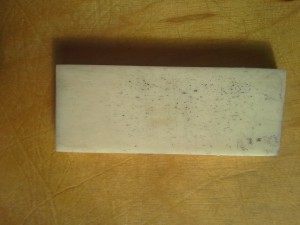We have a new mystery artist who is taking up residence as “Mystery Artist 21”. They had made a “story bracelet” some time ago, though we’re not sure of the material, it is a five charm bracelet set in sterling silver using a resin to hold the scrimshaws in place. You can see it at “Mystery Artist 21“
Category: FYI
Juma – A Composite Ivory Alternative
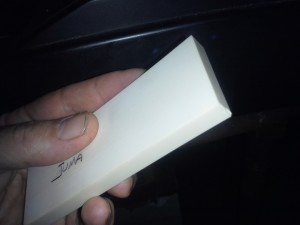
What is Juma?
Juma consists of a mixture of different mineral based materials in a resin component. Unlike casein juma can be thermoformed using boiling water (according to Atlas Billiard supply. Haven’t tried it yet myself).
Where does it come from?
Sources include Atlas Billiard Supply (cuestik.com) and suppliers in Europe (cuestik.eu)
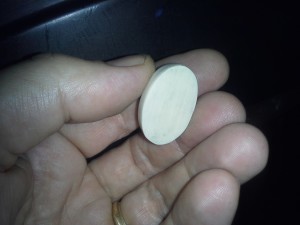
How well does it cut?
Juma is a different chemical makeup – it tends to cut similar to casein though it’s chip size is similar to Corian. Juma also does not have any distinct odor when it’s sanded, unlike Casein (which smells like bone) or Corian (which smells like acrylic). According to Atlas Billiard Supply, Juma is also FDA approved and can be used for smoking pipes and kitchen utensils.
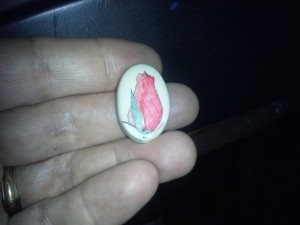
How well does it scrim?
Juma stipples well, cratering only slightly when stippled deeply, unlike polyester. It scribes well with a sharp tool, dusting on a long line rather than curling like ivory. Appears to be only slightly softer than ivory.
How well does it stain?
When polished, India ink and oil paint wipe off easily. If unpolished or only sanded to 400 grit the crevices will hold your pigment and make it look cloudy. Scribed and stippled lines come out crisp and well defined if the pigment is allowed to dry. Colored India inks hold well also.
Originally posted in the Scrimshaw.com Newsletter on June 14, 2015. For the latest information, tips and templates, subscribe to the newsletter – it’s low-carb, no spam, and you don’t need dramamine!
Just a quick note – Artists Page Updated
We’ve added a map to the Artists page (as I’ve been wanting to do for some time). The states in green are active with at least one artist linked to them on their own state page. This makes it easier for those interested to find out if there are artists in their area who may be able to do custom work. Let me know if you’re interested in having a link on the state page you reside in, I’ll be happy to add you (no charge). With enough interest I may add other countries as well. Thanks!
Nostalgic “Grandpa” Scrimshaws
This is an excerpt from the May 2015 Scrimshaw.com Newsletter. You can get these delivered to your inbox free by subscribing to the right —->

Thinking back to my grandparents, the Grampy’s always had some little thing that was special. They had the tiny pocket knife that always came in handy when you were fishing, the lighter with its trademark “click” before you smelled the sweet sceent of Borkum Riff tobacco curling from the pipe or the tie-tack or lapel pin they wore in church or on their hat along with their favorite fly fishing fly.
What are the nostalgic doo-dads, gee-gaws and keepsakes You or your significant other will pass down? Pocket knives still come in handy, lighters are used much less unless you’re a camper or fisher and tie tacks have given way to clips if a tie is worn at all. Electronics are swapped out every three years, so unless you make a cover or other contrivance that holds something electronic which will look nice as a standalone or incorporated into something else, it may not last as a piece of personal memorabilia. Here’s a list of scrimshaw-able items I was able to come up with:
- Keychains – people still need keys for their vehicles and homes. Depending on the number of keys you carry this may or may not work for scrimshaws, though “monkey fists” will work as an alternative (see “Weavers of Eternity” video to start, many more videos there).
- Knives – small knives are still great for every day use, coming in handy do open letters, packages, and those cursed hermetically sealed packages they put children’s toys in. There are many inexpensive small knives out there that use bone scales. You can also look for knives you can modify such as many of the Spyderco
and Magnum
. Look for hex nuts on the knife scales: you want to be able to disassemble and reassemble them. Also, be aware that some of the “assisted opening knives can be difficult to reassemble. You can also look for inexpensive kits
.
- Money Clips – handy, flashy, great as a theft deterrent (several ones with a $10 around the outside can be thrown in one direction as you run in the other – what’s a thief going to do: run after you or go for the money?)
- Cufflinks – small but memorable, they can be passed down to the kids or grand kids and will be cherished for years
- Business Card Holders – these are more of the things that the kids see on the dresser and remember, though they do come in handy as well for every day use, and can hold other small items as well.
- Lapel Pins – I still remember the Moose Club lapel pins and the Masons lapel pins.
- Lighters – The ubiquitous Zippo lighters. This is where you have to be careful to use materials and adhesives that won’t melt from coming into contact with lighter fluid. Adhesives I’ve found: Seal-All Gas & Oil Resistant Adhesive
So what fits on these tiny canvasses? Lapel pins, tie tacks/clips and cufflinks are so small, often times initials or basic shapes work the best. People need to be able to glance at it and identify it first, then be able to look at the details. I learned this lesson on a set of iris earrings I’d made. They looked beautiful under the microscope, I was especially proud of the shading I was able to achieve. Sadly when seen under normal viewing conditions, they looked like a purple blob and a green blob.
My initial thought on knife handles as canvasses were tall ships, lighthouses and shapely figures of beautiful women. Looking for examples I was pleasantly astounded to see so much more, including Katherine Plumer’s excellent Zebras. Garbo’s amazing tigers and so many more. (google scrimshaw knives).
Money clips usually have larger areas to scrimshaw (25mm and larger) and business card holders have a nice landscape or portrait area and lighters have up to two areas that can be utilized (the lid and the body).
Any of grandpa’s keepsake’s we’re missing? Let us know and we’ll include them in a future post.
Sealing Bone Scales – Take 2
Last time, we tried just filling the voids in the bone scales with wax. This gave us spotty results – literally. Working with a couple of different formulations of cyanoacylate, we’re at the point of – still looking.
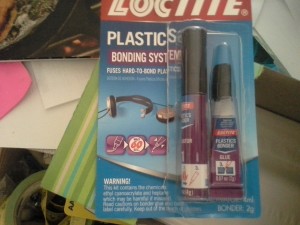
We attempted to follow the luthier’s method of building up the material with the bone dust from sanding the bone smooth and used Loctite Plastic Bonding System which had an “accelerator” in the form of a marker made for gluing difficult materials. This didn’t work well at all.
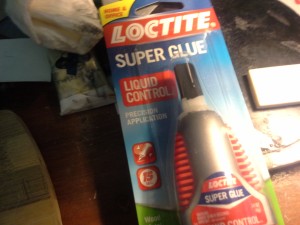
Next, we attempted to use some more off the shelf superglue – Loctite Super Glue LIQUID (not the gel, as we want this to seep into the cracks and fill them in). Piling the bone dust up and squirting the glue on made – a mess, though it might look better once it’s sanded down.
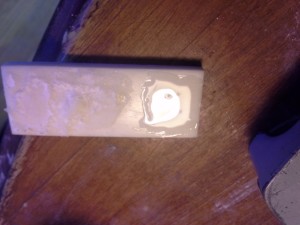
While we were waiting we looked at the other side of the bone and decided to just lay the glue straight down on that side to see if it worked any better. My thoughts at the moment are that either (1) the bone dust is too fine and can’t saturate well (like lumps in the pancake batter when you make it from scratch) or (2) I need an even slower curing superglue.
After letting it dry thoroughly, I proceeded to sand down both sides with 220 grit sandpaper, followed by 600, 1000, 1800, 3200 and finally 8000 grit pads. Wiping some oil paint across the whole piece and wiping it off, I find that the bone dust side is just as bad or worse than the untreated area (center), but the right side where we used no dust is looking pretty good! After 30 minutes the glue is still somewhat soft for scrimshawing. I’ll be testing it for “scrimmability” later in the week and will update my findings.
